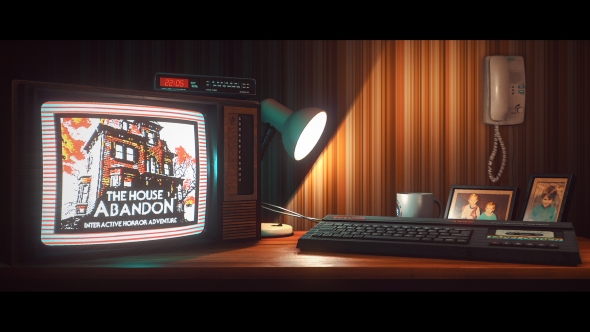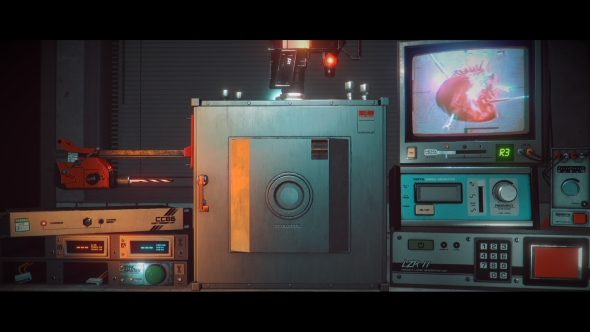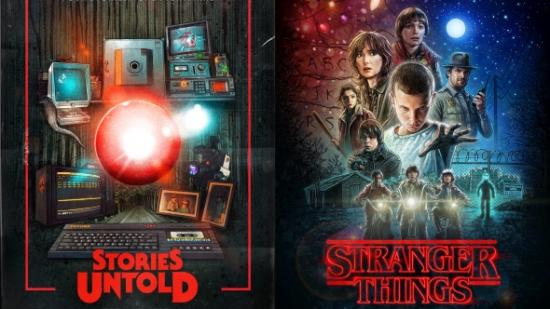Stories Untold is clearly using the widespread adoration of Netflix’s Stranger Things as a tool in its marketing. The superb cover art for the game, for example, is the work of Kyle Lambert, the same artist behind Stranger Things’ iconic poster. But while the episodic approach, creepy synth theme tune, and 80s title font suggest that it’s the Stranger Things: The Game, Stories Untold has next to nothing in common with the incredibly popular show. It’s not about childhood, friendship, loss, or creepy monsters. Despite that, it’s still as essential for anyone with a deep-held love for 1980s nerd culture.
Play a classic with our favourite old school games.
The game features four episodes, each using a unique setup to deliver an unsettling short story. Within the fiction of the game they’re the remains of cancelled TV series, also called Stories Untold, and so each is presented with opening and end credits. For film buffs they’re not quite as exciting as Stranger Things’ intro – they don’t replicate the optical Kodalith process with light leaks, fuzzy edges, and jitters – but that’s not what the focus is. That 80s texture is replicated with props and gameplay decisions rather than directorial and visual style.
The House Abandon, Stories Untold’s opening episode, takes place entirely in front of a Futuro 128k home computer. It’s a fictional machine, but the rainbow logo design on the right-hand edge of the keyboard will make you all nostalgic for the Spectrum ZX. The TV it’s hooked up to is encased in cheap dark wood veneer, and the screen is beautifully low-res. It’s immediately obvious that developers No Code previously worked on Alien: Isolation’s retro user interface. The House Abandon is a classic ‘80s-style text adventure, both in the episode’s gameplay design and within the lore of Stories Untold, and when typing in commands you can hear the heavy thuds and clicks of the Futuro’s keyboard. It creates a deeply authentic atmosphere, despite the scene been almost entirely static.
Further episodes introduce more period-authentic machines to interact with, each new device dictating what kind of gameplay approach the story will take. Episode two is set in a science laboratory, and demands the precise use of a multitude of X-ray machines, wavelength tuners, and drills to conduct a mysterious experiment. The following chapter involves heavy use of a microfilm reader; you need to operate the focus, tilt, zoom, and slide dials individually to read an operator’s manual. It’s all incredibly tactile and satisfyingly analogue. Both chapters pay homage to point-and-click games, another ‘80s staple, and become progressively more advanced than The House Abandon’s text-only interface.

Despite being magnitudes more advanced than the games of the 1980s, Stories Untold plays loving homage to those games in all the ways it’s presented. Each episode takes place at a stationary desk that you can’t move away from. These feel suitably akin to the static, lifeless environments of old titles. No doubt Stories Untold was made on a tiny budget, but they’ve made the most of their own limitations by recreating an era absent of high-octane action and pixel-perfect particle effects. It also means that when the game breaks from these established low-fi conventions such moments feel incredibly unnerving. It’s effective horror born out of rule breaking.
Stories Untold may not opt for the Spielbergian tones of Stranger Things, but both have a shared love of Stephen King-grade horror. Expect the paranormal, but not of the same school as The Upside-Down and Eleven. The narrative cards are held closely and dealt slowly and incompletely; by the end of each episode you’ll only have a vague understanding of the ordeal you’ve been forced through. It understands that the untold details of a story can be the most effective, and so leaves much interpretation up to you. Certainly the imagination of many players is spookier than anything No Code could have written, but no doubt there will be a sizeable portion of the audience who finds this lack of answers more infuriating than effective.

For all the correct steps that Stories Untold takes, it does stumble a couple of times. For the most part it’s fairly self-explanatory, but when more difficult puzzles arise there’s nothing to guide lost players. I spent an inordinate amount of time on a section in the second episode, solving it by mindlessly tapping keys rather than finding the conclusion through logic. Such hint-less puzzles feel authentically 1980s in their construction, but the appeal soon falters when you feel like you’ve hit an impossible barrier. Episode three also proved frustrating in its own way; the authentically scratched and worn microfilm can be difficult to read, and the fiddly nature of the machine quickly loses its novelty since you’re required to use it every couple of minutes.
Such issues are far from deal breakers, though. In a game as short as this (the whole experience clocks in at around three hours) we’re talking mere minutes of frustration. And even if you spend a higher proportion of time wrestling with unclear puzzles, unreadable text, and some incredibly unwieldy mouse movement in the later stages, these still won’t be the things that stick in your mind hours and days after the last set of credits roll. Instead, you’ll be thinking about how No Code successfully brought the 1980s into the modern day. How they repurposed a text adventure as a meta horror tale. How they made the simple act of pressing enter an exercise in fearful anticipation.
Outside its base influences and 80s aesthetic, there’s little that Stories Untold shares in common with Stranger Things. But they both draw upon and do interesting things with the mediums that inspired them. Stranger Things created an original story using the cinematic language of the era, and as a result feels like a perfect 80s relic that got misplaced in the time stream. Stories Untold, on the other hand, replicates the games of the 1980s and subverts them in a way that’s completely modern. A text adventure isn’t just a text adventure. Standalone episodes aren’t just standalone. And 80s cool isn’t just nostalgic fluff. And, when put like that, perhaps Stories Untold is an even better offering than Stranger Things: The Game.
